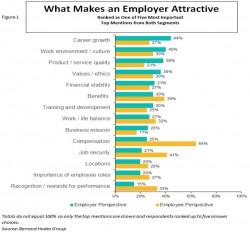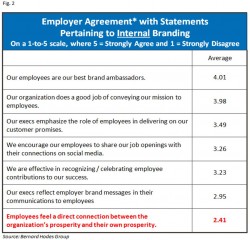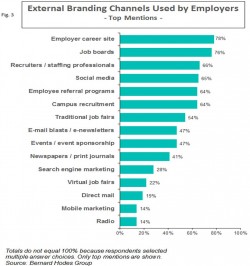 Most organizations need to work on how they develop and articulate their employer brand strategies. Just over half of employers claim to have an employer brand strategy (51%), a fifth (19%) are in the process of revising one, and 24% are working towards one. That’s what Bernard Hodes Group learned from our new research, called The Growing Value of Employer Brands.
Most organizations need to work on how they develop and articulate their employer brand strategies. Just over half of employers claim to have an employer brand strategy (51%), a fifth (19%) are in the process of revising one, and 24% are working towards one. That’s what Bernard Hodes Group learned from our new research, called The Growing Value of Employer Brands.
Of those employers that claim to have a strategy, the average age of it is 4.3 years. The results suggest that many employers are using strategies pre-dating the Great Recession. Relying on an old strategy is a recipe for disaster given the changes in workers’ attitudes wrought by turbulent labor markets and the rise of new channels such as social media.
The survey polled 175 employers across the U.S. in a spectrum of industries from education to manufacturing. About 240 employees were surveyed and were not necessarily employed by any of the participating employers. When comparing the two sets of data, there are some stark disconnects (see the graphic in the upper right). Some of the most noteworthy include:
- Only 25% of employers indicated that compensation is one of the most important attributes of an employer brand, compared with 64% of employees.
- Job security was ranked highly by 41% of employees, but only 21% of employers.
- Just 15% of employers felt that recognition is important in attracting new hires, while 33% of employees ranked it highly.
- Nearly half of employers (44%) felt career growth and advancement opportunities are important to attracting talent, while just over a quarter of talent (27%) agreed.
Looking at the data, one gets the impression that many employers may have lost common sense.
Compensation, benefits, and recognition are still important to job seekers, but employers may have downplayed those attributes of employer brands due to recently scaling back to trim costs. Job security, of course, is something no employer can promise, but if an organization has a record of stability, the data suggests it could be a powerful selling point in today’s more sober labor market.
Employers’ Frustrations
 Employers have their share of disappointments as well. Most tended to disagree with the statement, “Employees feel a direct connection between the organization’s prosperity and their own prosperity” (see the graphic at right). Whether this is an acknowledgment that the organization’s efforts to educate workers on their role in the enterprise’s success have fallen short, or an implicit admission that employers are simply no longer “sharing the wealth,” is unknown.
Employers have their share of disappointments as well. Most tended to disagree with the statement, “Employees feel a direct connection between the organization’s prosperity and their own prosperity” (see the graphic at right). Whether this is an acknowledgment that the organization’s efforts to educate workers on their role in the enterprise’s success have fallen short, or an implicit admission that employers are simply no longer “sharing the wealth,” is unknown.
Employers estimated that, on average, one-quarter (23%) of employees would refer friends or former colleagues to an opening, while 60% of workers said they would refer someone they knew to their employer. This disconnect may be due in large part to employers either not having a formal referral policy or neglecting to promote the one they have. The finding suggests that if employers put some effort into motivating employee referrals they could reap significant rewards.
Employee engagement surveys are the most commonly used tool to measure employer brand strength (63% of employers), and the scores from those surveys provide the metrics used to judge the success of employer branding efforts (according to 56% of employers). Employers can take comfort, then, in the knowledge that the overwhelming majority of employees who responded (72%) felt that they are “closely matched to their employer.”
Employers Ahead — or Behind — of Employees?
 When asked about tactics, it appears that employers for once are out ahead of workers when it comes to recruiting efforts (check out the visual on the right). While almost two-thirds of employers (65%) say they are using social media to attract new talent, only 29% of employees say they use social media to look for new opportunities.
When asked about tactics, it appears that employers for once are out ahead of workers when it comes to recruiting efforts (check out the visual on the right). While almost two-thirds of employers (65%) say they are using social media to attract new talent, only 29% of employees say they use social media to look for new opportunities.
There have been other studies that suggest some people like to keep their social media experiences more personal and less formal. Another explanation could be those individuals using social media are in the vanguard technically, and with technical opportunities going begging, a strong social media presence puts the employer in front of the most difficult-to-hire talent. For employers, this means having a social presence now will appeal to the most tech-savvy talent while establishing a brand that will be waiting when the mainstream begins to shift towards the channel.
Surprisingly, nearly half (41%) of employers report they still use newspaper or print advertising. The percentage of those recruiters using mobile media — mobile-enabled Web sites or text messaging — barely registered, despite the meteoric growth of smartphone usage in the U.S. (now over 50%). Nearly half of employers (47%) report using e-mail or e-newsletters to recruit, despite evidence that 18- to 34-year olds are dropping e-mail in favor of instant messaging or apps. A study published by Business Insider found that advertisers in general spent 29% of their budgets on print, a medium where the average American spends 6% of their day, and spend roughly 1% on mobile advertising, where we spend 23% of our day. Clearly, change is coming; these disparities suggest it is inevitable.
What’s Next
The study has many other surprises embedded. Perhaps this is to be expected, given the rough ride our economy is hopefully finishing. One feels like they are coming out of their storm cellars and surveying the wreckage. Now that the economic “storm” has passed, it’s time to start getting back to work. Here’s how:
- Make sure your employer brand is an authentic reflection of the current organization. If you haven’t revised your employer brand since the last decade, it’s time to revisit it. Evaluate it in light of the changes your organization went through since 2007, as well as new communications channels (which were barely a blip on the radar five years ago).
- Make a concerted effort to understand your employees and candidates. Beware of drinking your “company Kool-Aid.” Don’t assume because your CEO thinks it’s a great place to work that your rank and file share the passion. Survey your workers (and do so in ways that ensure their anonymity; these days, everyone assumes you will try to weed out naysayers, and employees’ responses will be guarded and skew to the overly positive). Use employee communications as a dialogue rather than a broadcast medium. When all else fails, put yourself in their shoes.
- Use metrics to build the case for a strong employer brand as a foundation for operational excellence. Many of the issues this research uncovered stem from cutbacks made during the Great Recession. No one is naïve enough to believe that those could have been completely avoided, but if a tighter link between excellent results and a strong employer brand is established, the next time cost-cutting is needed, it may not all fall on HR’s plate. Make sure the metrics you use matter to the key decision-makers on your executive committee (not just the head of HR). If you can dazzle the CFO, you’ll know you have a hit on your hands.